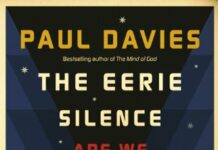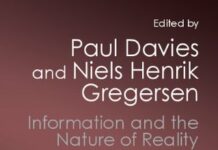
Ebook Info
- Published: 2004
- Number of pages: 232 pages
- Format: PDF
- File Size: 2.02 MB
- Authors: Paul Davies
Description
In this critically acclaimed book, first published in 1988 and now reprinted in paperback, scientist and author Paul Davies explains how recent scientific advances are transforming our understanding of the emergence of complexity and organization in the universe.Melding a variety of ideas and disciplines from biology, fundamental physics, computer science, mathematics, genetics, and neurology, Davies presents his provocative theory on the source of the universe’s creative potency. He explores the new paradigm (replacing the centuries-old Newtonian view of the universe) that recognizes the collective and holistic properties of physical systems and the power of self-organization. He casts the laws in physics in the role of a “blueprint,” embodying a grand cosmic scheme that progressively unfolds as the universe develops.Challenging the viewpoint that the physical universe is a meaningless collection particles, he finds overwhelming evidence for an underlying purpose: “Science may explain all the processes whereby the universe evolves its own destiny, but that still leaves room for there to be a meaning behind existence.”
User’s Reviews
Editorial Reviews: Review “Unquestionably, Paul Davies has established himself as one of the most felicitous writers on physics at the frontier.” About the Author Paul Davies is professor of natural philosophy in the Australian Centre for Astrobiology at Macquarie University. His research has spanned the fields of cosmology, gravitation, and quantum field theory, with particular emphasis on black holes and the origin of the universe. He is currently working on the problem of the origin of life and the search for life on Mars. He is a well-known author, broadcaster, and public lecturer and has written over twenty-five books. Among his better-known works are God and the New Physics, The Mind of God, About Time, The Fifth Miracle, and How to Build a Time Machine. In recognition of his work as an author, he was elected as fellow of The Royal Society of Literature in 1999.His contributions to science have been recognized by numerous awards, including the 2002 Michael Faraday Prize by the Royal Society and the 2001 Kelvin Medal and Prize from the U.K. Institute of Physics. In April 1999 the asteroid 1992 OG was officially named (6870) Pauldavies in his honor. His most significant award was the 1995 Templeton Prize for Progress in Religion, the world’s largest prize for intellectual endeavor.
Reviews from Amazon users which were colected at the time this book was published on the website:
⭐Good read.
⭐Thoughtful and informative.
⭐Davies is amazing again!
⭐This (2004 edition) is an updated re-publication of Davies’ 1988 book. In the new preface, Davies (mathematical physicist, prolific writer, recipient of the Faraday Prize, the Kelvin Medal, and the Templeton Prize) suggests the possibility of something quite outlandish–that if humanity can somehow survive the full future of the universe, that upon the universe’s thermodynamic and quantum demise, our descendants might scramble into a new universe of their own manufacture. The assertion brings several thoughts to mind, we might begin with, well, let’s say, idea-heisting [I’ll not say plagiar_sm, that would be a bit harsh]. (Frank Tipler famously envisioned this kind of scenario in a universe headed for a “big crunch.” The big crunch has currently fallen out of favor with astronomers and theorists, and Davies’ invented universe envisions the currently favored thermodynamic “big fade away” scenario.) It also might strike us as unrealistic or even arrogant; but, foolish or not, Davies’ reason for such ‘optimism’ is unveiled in the following 200 pages.What follows is a fast-paced and critical tour-de-force of the state of current and emerging scientific theories and prospects (promising and otherwise) for the future. There are many outstanding discussions, one centered on the mathematics of self-similar scaling — the “Mandelbrot set” being a famous example. Davies believes that, in principle, science will one day explain, comprehensively, how the world works. Don’t hold your breath, we’re not exactly close to that day just yet. In some significant areas, notably the deepest theoretical understandings of biological and mind sciences, there seems to have been rather little progress at all. From popular treatments [like glossy spreads in National Geographic magazine, or Discovery Channel shows], one might be led to believe that great insights have been gained into how biological evolution proceeds and how life arises spontaneously from non-life. Davies surveys the competing claims and theories in these disciplines and exposes them as being starkly impotent to date. (There is a popular myth that only religious fundamentalists are skeptical of the neo-Darwinian story line — but many of the most penetrating minds of modern theoretical science and mathematics, including Werner Heisenberg, Niels Bohr, John von Neumann, and Kurt Godel, among others, have found the Darwinian story to be non-compelling at best, and on some points glaringly wrong. As Davies points out, a world in which ‘natural selection’ was The Great Generative Engine, supporting only reproductive advantages, many life forms that we observe, like elephants [low birth rate, long gestation period, etc], could not have been ‘selected’ into existence. It does no good to protest that elephants should not and could not reproduce like bunnies — in a truly Darwinian world there simply should not be elephants [or humans: striving to discern whether the universe might be headed toward a ‘big crunch’ or a ‘heat death’ can offer no reproductive advantage for beings given to contemplating such things!]. One thinks of many Darwin-confuters in the plant kingdom. A world built by Darwinian mechanisms would be populated only by masters of mitosis, and perhaps sex-maniacs that mated like bunnies, although sex itself, a comparatively inefficient means of reproduction [obviously when compared to mitotic reproduction], is another intractable problem for the Darwinian story.) Davies, like many noted physicists, is well studied and articulate in theoretical biology, and finds the state of neo-Darwinian evolutionary theory to be mostly a patched-up, just-so story that is easy fodder for skepticism. He does, however, believe that Stuart Kaufmann’s ideas concerning holistic approaches to understanding complexity may be more fruitful. However I give a wrong impression if I seem to suggest that the book is largely about biological evolution, it is not. This is but one of several illuminating discussions, most of which understandably center on mathematical physics.Davies, an epistemological optimist at any rate, expects that theoretical biology and mind science will one day succumb to our advancing knowledge, and that we will know, exhaustively, how the world works. But to know how the world works is not to know why the world works. Even if science should attain a reductionistic “theory of everything” and a stunning cadre of holistic theories explaining all features of ’emergence’ and ‘complexity’, the big Why question(s) will remain, and any answers will remain as matters of faith, not strict science. Science speaks to “how,” but why should this be so? Why should there be an explainable world and why should it contain world-explainers? One can deny teleological inference and many materialists insist [religiously] on doing so, but the denial is one of personal choice, not actual science. The world IS ‘up to something,’ and this fact IS fundamentally written into the new physics. The mysterious profundity of “why” always remains. In the day that Davies foresees, when physical science has achieved its final triumph, it will not have dispensed with God and it will not have written purpose out of the world.Well, that’s the book in a nutshell, but there’s much more to it. I’ve read something like ten of Davies’ books; most of them being either ‘good’ or ‘very good’ (with one notable exception) and this volume fits either category, except, perhaps, for that wild assertion in the new preface.
⭐The Cosmic Blueprint: New discoveries in nature’s creative ability to order the universe, by Paul Davies, Simon and Schuster (Orion), 1988; Templeton Foundation Press (US), 2004, 240 ff.The key issue of this book is the author’s contention that there is meaning in the universe, even if organization and emergent complexity are built into the nature of the atoms and the structures of the molecules that they form, especially the molecules of living matter. Paul Davies was on the staff of Macquarie University, Sydney, when this book was written but is now on the staff of the State University of Arizona where he is Director of a Center for Fundamental Concepts in Science, exploring subjects as diverse as cancer and the search for extra-terrestrial life.The quotation from Ilya Prigogine that heads Chapter 1 sets the tone of this book and makes it clear why it was republished by the Templeton Foundation: `God is no more an archivist unfolding an infinite sequence he had designed once and forever. He continues the labour of creation throughout time.’ This is the constantly evolving God of Whitehead’s Process Theology. Though Davies totally rejects vitalism (the presence of a special `life force’ in living organisms), he accepts that the universe behaves “as if” it was designed with a purpose, and he skilfully uses a fusion of particle physics, biology, psychology and cosmology to show how `the universe evolves its own destiny’ in such a way as to `leave room for there to be a meaning behind existence.’ This organizing principle or consciousness is what some mystics of the East and theists of the West call God or Infinite Mind. The laws of physics and the natural constants provide the blueprint or software for the universe to evolve.The chapter headings deal with subjects as diverse as Complexity, Self-Organization and Chaos, the Nature, Origin and Evolution of Life, the Quantum Factor, and Mind and Brain. As usual with Davies, the writing is clear and he covers complex subjects without any of the underlying mathematics, except for a couple of brief references to Lagrangians and differential equations (without the sums!). The book is a challenging and thought-provoking read but some grounding in science for readers is desirable if they are to get the best out of it. There are 17 pages of References, Further Reading and an Index.
⭐
⭐Howard Jones is the author of The World as Spirit
⭐The Cosmic Blueprint: New discoveries in nature’s creative ability to order the universe, by Paul Davies, Simon and Schuster (Orion), 1988; Templeton Foundation Press, 2004, 240 ff.The self-organizing universeBy Howard A. JonesThe key issue of this book is the author’s contention that there is meaning in the universe, even if organization and emergent complexity are built into the nature of the atoms and the structures of the molecules that they form, especially the molecules of living matter. Paul Davies was on the staff of Macquarie University, Sydney, when this book was written but is now on the staff of the State University of Arizona where he is Director of a Center for Fundamental Concepts in Science, exploring subjects as diverse as cancer and the search for extra-terrestrial life.The quotation from Ilya Prigogine that heads Chapter 1 sets the tone of this book and makes it clear why it was republished by the Templeton Foundation: `God is no more an archivist unfolding an infinite sequence he had designed once and forever. He continues the labour of creation throughout time.’ This is the constantly evolving God of Whitehead’s Process Theology. Though Davies totally rejects vitalism (the presence of a special `life force’ in living organisms), he accepts that the universe behaves “as if” it was designed with a purpose, and he skilfully uses a fusion of particle physics, biology, psychology and cosmology to show how `the universe evolves its own destiny’ in such a way as to `leave room for there to be a meaning behind existence.’ This organizing principle or consciousness is what some mystics of the East and theists of the West call God or Infinite Mind. The laws of physics and the natural constants provide the blueprint or software for the universe to evolve.The chapter headings deal with subjects as diverse as Complexity, Self-Organization and Chaos, the Nature, Origin and Evolution of Life, the Quantum Factor, and Mind and Brain. As usual with Davies, the writing is clear and he covers complex subjects without any of the underlying mathematics, except for a couple of brief references to Lagrangians and differential equations (without the sums!). The book is a challenging and thought-provoking read but some grounding in science for readers is desirable if they are to get the best out of it. There are 17 pages of References, Further Reading and an Index.Dr Howard A. Jones is the author of The Thoughtful Guide to God (2006) and The Tao of Holism (2008), both published by O Books of Winchester, UK.
⭐Creative Evolution: A Physicist’s Resolution Between Darwinism and Intelligent Design: A Quantum Resolution Between Darwinism and Intelligent Design
⭐
⭐Mind Before Matter: Visions of a New Science of Consciousness
⭐
⭐Complexity: The Emerging Science at the Edge of Order and Chaos (Penguin Science)
⭐
⭐The End of Materialism: How Evidence of the Paranormal is Bringing Science and Spirit Together (Ions / Nhp)
⭐This is my husband’s purchase!
Keywords
Free Download Cosmic Blueprint: New Discoveries In Natures Ability To Order Universe in PDF format
Cosmic Blueprint: New Discoveries In Natures Ability To Order Universe PDF Free Download
Download Cosmic Blueprint: New Discoveries In Natures Ability To Order Universe 2004 PDF Free
Cosmic Blueprint: New Discoveries In Natures Ability To Order Universe 2004 PDF Free Download
Download Cosmic Blueprint: New Discoveries In Natures Ability To Order Universe PDF
Free Download Ebook Cosmic Blueprint: New Discoveries In Natures Ability To Order Universe



